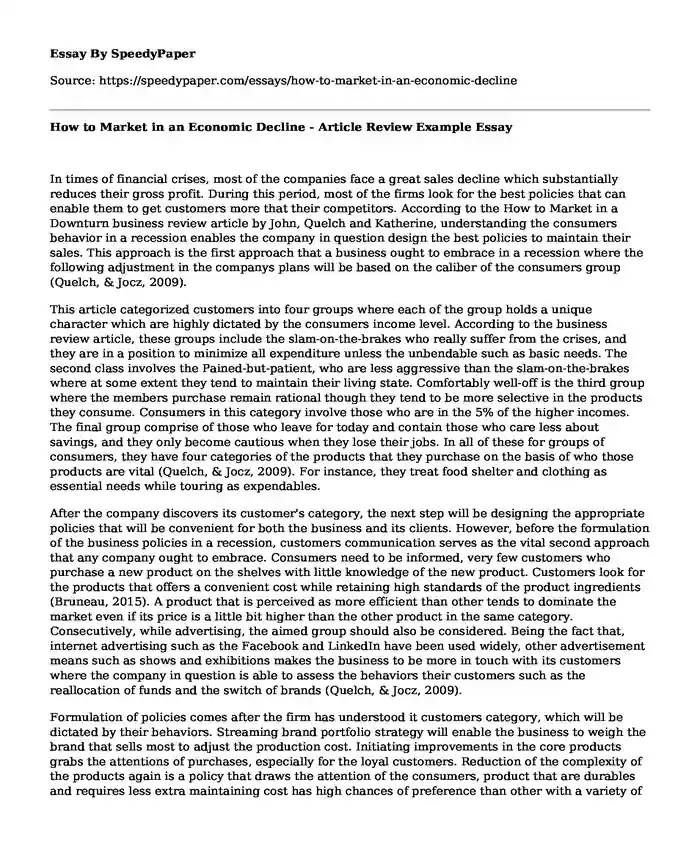In times of financial crises, most of the companies face a great sales decline which substantially reduces their gross profit. During this period, most of the firms look for the best policies that can enable them to get customers more that their competitors. According to the How to Market in a Downturn business review article by John, Quelch and Katherine, understanding the consumers behavior in a recession enables the company in question design the best policies to maintain their sales. This approach is the first approach that a business ought to embrace in a recession where the following adjustment in the companys plans will be based on the caliber of the consumers group (Quelch, & Jocz, 2009).
This article categorized customers into four groups where each of the group holds a unique character which are highly dictated by the consumers income level. According to the business review article, these groups include the slam-on-the-brakes who really suffer from the crises, and they are in a position to minimize all expenditure unless the unbendable such as basic needs. The second class involves the Pained-but-patient, who are less aggressive than the slam-on-the-brakes where at some extent they tend to maintain their living state. Comfortably well-off is the third group where the members purchase remain rational though they tend to be more selective in the products they consume. Consumers in this category involve those who are in the 5% of the higher incomes. The final group comprise of those who leave for today and contain those who care less about savings, and they only become cautious when they lose their jobs. In all of these for groups of consumers, they have four categories of the products that they purchase on the basis of who those products are vital (Quelch, & Jocz, 2009). For instance, they treat food shelter and clothing as essential needs while touring as expendables.
After the company discovers its customer's category, the next step will be designing the appropriate policies that will be convenient for both the business and its clients. However, before the formulation of the business policies in a recession, customers communication serves as the vital second approach that any company ought to embrace. Consumers need to be informed, very few customers who purchase a new product on the shelves with little knowledge of the new product. Customers look for the products that offers a convenient cost while retaining high standards of the product ingredients (Bruneau, 2015). A product that is perceived as more efficient than other tends to dominate the market even if its price is a little bit higher than the other product in the same category. Consecutively, while advertising, the aimed group should also be considered. Being the fact that, internet advertising such as the Facebook and LinkedIn have been used widely, other advertisement means such as shows and exhibitions makes the business to be more in touch with its customers where the company in question is able to assess the behaviors their customers such as the reallocation of funds and the switch of brands (Quelch, & Jocz, 2009).
Formulation of policies comes after the firm has understood it customers category, which will be dictated by their behaviors. Streaming brand portfolio strategy will enable the business to weigh the brand that sells most to adjust the production cost. Initiating improvements in the core products grabs the attentions of purchases, especially for the loyal customers. Reduction of the complexity of the products again is a policy that draws the attention of the consumers, product that are durables and requires less extra maintaining cost has high chances of preference than other with a variety of attractive features (Bruneau, 2015).
In conclusion, in the financial crises times, the consumers look forward to the companies that are willing to get them through such hard times. Convening a reassurance message which shows empathy such as we care for you in all circumstances plays a significant role in not only maintaining of the customer but also building the client's trust.
References
Bruneau, C. L. (2015). BMKT 337.02: Consumer Behavior.
Quelch, J. A., & Jocz, K. E. (2009). How to Market in a Downturn. Harvard Business Review, 87(4), 52-62.
Cite this page
How to Market in an Economic Decline - Article Review Example. (2019, Oct 01). Retrieved from https://speedypaper.net/essays/how-to-market-in-an-economic-decline
Request Removal
If you are the original author of this essay and no longer wish to have it published on the SpeedyPaper website, please click below to request its removal:
- Essay Example about Abortion as a Threat to the Society
- Creativity and Age Essay Sample
- Growing Threat - Free Essay Dedicated to Terrorism
- Free Essay on Social Media and Young Generation in American
- Free Essay Focusing on the Cost of Loving Others
- Essay Example: ET Culture, Close Encounters of the Nth Kind
- How core-based consumption causes an economic change in periphery cultures
Popular categories





